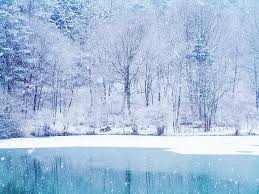Winter Wallpaper Backgrounds Biography
Winter is the coldest season of the year in temperate climates, between autumn and spring. At the winter solstice, the days are shortest and the nights are longest, with days lengthening as the season progresses after the solstice.Some authorities attempt to define an astronomical winter, often offset, which is based solely on the position of the Earth in its orbit around the sun. The start of an astronomical winter remains constant in each hemisphere regardless of weather conditions, but varies with culture.
Meteorological winter is the method of measuring the winter season used by meteorologists based on "sensible weather patterns" for record keeping purposes,so the start of meteorological winter can change depending on how far north one lives.Winter is often defined by meteorologists to be the three calendar months with the lowest average temperatures. This corresponds to the months of December, January and February in the Northern Hemisphere, and June, July and August in the Southern Hemisphere. The coldest average temperatures of the season are typically experienced in January in the Northern hemisphere and in June or July in the Southern hemisphere. Nighttime predominates the winter season, and in some regions it has the highest rate of precipitation as well as prolonged dampness because of permanent snow cover or high precipitation rates coupled with low temperatures, precluding evaporation. Blizzards often develop and cause many transportation delays. A rare meteorological phenomenon encountered during winter is ice fog, which comprises ice crystals suspended in the air; it occurs only at very low temperatures, below −30 °C (−22 °F).Accumulations of snow and ice are commonly associated with winter in the Northern Hemisphere, due to the large land masses there. In the Southern Hemisphere, the more maritime climate and the relative lack of land south of 40°S makes the winters milder; thus, snow and ice are less common in inhabited regions of the Southern Hemisphere. In this region, snow occurs every year in elevated regions such as the Andes, the Great Dividing Range in Australia, and the mountains of New Zealand, and also occurs in the southerly Patagonia region of South America. Snow occurs year-round in Antarctica.Astronomically, the winter solstice, being the day of the year which has fewest hours of daylight, ought to be the middle of the season.








Winter is the coldest season of the year in temperate climates, between autumn and spring. At the winter solstice, the days are shortest and the nights are longest, with days lengthening as the season progresses after the solstice.Some authorities attempt to define an astronomical winter, often offset, which is based solely on the position of the Earth in its orbit around the sun. The start of an astronomical winter remains constant in each hemisphere regardless of weather conditions, but varies with culture.
Meteorological winter is the method of measuring the winter season used by meteorologists based on "sensible weather patterns" for record keeping purposes,so the start of meteorological winter can change depending on how far north one lives.Winter is often defined by meteorologists to be the three calendar months with the lowest average temperatures. This corresponds to the months of December, January and February in the Northern Hemisphere, and June, July and August in the Southern Hemisphere. The coldest average temperatures of the season are typically experienced in January in the Northern hemisphere and in June or July in the Southern hemisphere. Nighttime predominates the winter season, and in some regions it has the highest rate of precipitation as well as prolonged dampness because of permanent snow cover or high precipitation rates coupled with low temperatures, precluding evaporation. Blizzards often develop and cause many transportation delays. A rare meteorological phenomenon encountered during winter is ice fog, which comprises ice crystals suspended in the air; it occurs only at very low temperatures, below −30 °C (−22 °F).Accumulations of snow and ice are commonly associated with winter in the Northern Hemisphere, due to the large land masses there. In the Southern Hemisphere, the more maritime climate and the relative lack of land south of 40°S makes the winters milder; thus, snow and ice are less common in inhabited regions of the Southern Hemisphere. In this region, snow occurs every year in elevated regions such as the Andes, the Great Dividing Range in Australia, and the mountains of New Zealand, and also occurs in the southerly Patagonia region of South America. Snow occurs year-round in Antarctica.Astronomically, the winter solstice, being the day of the year which has fewest hours of daylight, ought to be the middle of the season.
Winter Wallpaper Backgrounds
Winter Wallpaper Backgrounds
Winter Wallpaper Backgrounds

Winter Wallpaper Backgrounds

Winter Wallpaper Backgrounds

Winter Wallpaper Backgrounds
Winter Wallpaper Backgrounds

Winter Wallpaper Backgrounds

Winter Wallpaper Backgrounds
Winter Wonderland Android Snowfall Live Wallpaper 3 In 1 (Full Version)
Cool Winter Board Backgrounds/Themes
No comments:
Post a Comment